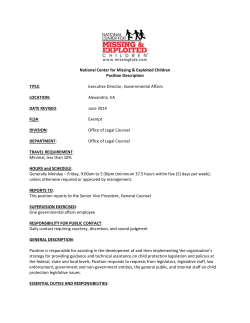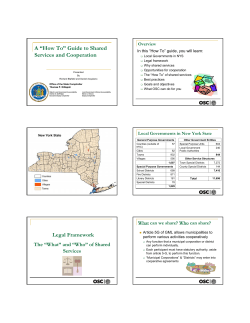
Initiative & Referendum Institute
In i t i a t ive & Re f e r e n d u m In s t i t u t e I & R F AC T S H E E T Number One WHAT IS INITIATIVE AND REFERENDUM? “[The Initiative is] the means by which voters can correct legislative sins of omission and the popular referendum as the means of correcting legislative sins of commission.” David B. Magleby, Author of Direct Legislation Voting on Ballot Propositions in the United States (1984) Important Facts • There are two types of Initiative – Direct and In-direct. • There are two types of Referendum – Popular and Legislative. • 27 states have some form of Initiative or Popular Referendum. • 24 states have a form of Initiative. • 24 states have Popular Referendum. • 49 states have Legislative Referendum. • Hundreds of cities and counties have some form of Initiative and Popular Referendum. —————— IRI —————— Initiative & Referendum Institute 1825 Eye Street, NW, Suite 400 Washington, DC 20006 Phone: 202.429.5539 / Fax: 202.986.3001 http://www.iandrinstitute.org http://www.ballotwatch.org M. Dane Waters President mdanewaters@iandrinstitute.org The Initiative & Referendum Institute is a 501(c)(3) non-profit tax-exempt educational organization dedicated to protecting and educating the people on the Initiative and Referendum process. In many states, citizens have the ability to adopt laws or to amend the state constitution. This is commonly referred to as the Initiative process. In many of the same states, as well as others, the citizens have the ability to reject laws or amendments proposed by the state legislature. This process is commonly referred to as the Referendum process. The Initiative process is used much more frequently than the Referendum process and is considered by many the more important and powerful of the two processes. There is no national Initiative process in the United States, but 24 states (see page two for complete list) have some form of Initiative – either Direct or Indirect. Direct Initiative is when constitutional amendments or statutes proposed by the people are directly placed on the election ballot and then submitted to the people for their approval or rejection (the state legislature has no role in this process). Indirect Initiative is when statutes or amendments proposed by the people through a petition must first be submitted to the state legislature during a regular legislative session. If the legislature fails to approve the statute or amendment or it amends the proposal in a manner that is not acceptable to the proponents of the proposal, the proponents may proceed to collect the additional signatures, if required, to have the original proposal submitted to the voters. Some states allow their legislature to submit an alternative proposal on the same subject as the initiated proposal for the people to choose between. There is no national Referendum process in the United States, but 49 states (see page two for complete list) have some form of Referendum – either Popular or Legislative. Popular Referendum is when the people have the power to refer, through a petition, specific legislation that was enacted by their legislature for the people to either accept or reject. Legislative Referendum is when the state legislature, an elected official, state appointed constitutional revision commission or other government agency or department submits propositions (constitutional amendments, statutes, bond issues, etc.) to the people for their approval or rejection. This is either constitutionally required, as in proposing constitutional amendments, or Thomas Jefferson was a strong advocate of the Legislative Referendum process and first proposed its use in the 1775 Virginia state constitution. because the legislature, government official or agency voluntarily chooses to submit the proposal to the people. Every state but Delaware requires that constitutional amendments proposed by the legislature be submitted to the citizenry via Legislative Referendum for approval or rejection. In addition to the states listed on page two, citizens in hundreds of cities and counties have adopted Initiative and Popular Referendum including; Washington, DC; New York City, New York; Los Angeles, California and Houston, Texas to name a few. -the end- xi x ix viii vii vi v iv iii ii i 1959 1912 1909 1911/66 1912 1972 1912 1970 1910 1908 1915 1918 1908 1992 1906 1904/72 1912 1904 1910 1914 1912 1907 1902 1898/72/88 1900/17 1912 1968 27 states Alaska Arizona Arkansas California vii Colorado Florida Idaho Illinois viii Kentucky Maine Maryland Massachusetts Michigan Mississippi Missouri Montanaix Nebraska Nevada New Mexico North Dakotax Ohio Oklahoma Oregon South Dakotaxi Utah Washington Wyoming Totals X X X X X X X X ¡ X ¡ X X X X X X X ¡ X X X X X X X X 24 states Initiative X X X X X ¡ X ¡ X X X X X ¡ X X X X X X X X X X X X X 24 states Popular Referendum Type of process available X X X X X ¡ X ¡ ¡ X ¡ X X ¡ X X X X ¡ X X X X X X X X 21 states ¡ X X X X X ¡ X ¡ ¡ ¡ X X X X X X X ¡ X X X X X ¡ ¡ ¡ 18 states ¡ X X X X X ¡ X ¡ ¡ ¡ ¡ X ¡ X X X X ¡ X X X X X ¡ ¡ ¡ 16 states Direct (DA) ¡ ¡ ¡ ¡ ¡ ¡ ¡ ¡ ¡ ¡ ¡ X ¡ X ¡ ¡ ¡ ¡ ¡ ¡ ¡ ¡ ¡ ¡ ¡ ¡ ¡ 2 states In-direct (IDA) Type of Initiative process used to propose Constitutional Amendments Legend ¡ = process not currently allowed by the state constitution. X = process currently allowed by the state constitution. Statute Constitutional Amendment Type of Initiative process available X X X X X ¡ X ¡ ¡ ¡ ¡ ¡ ¡ ¡ X X X ¡ ¡ X ¡ X X X X X X 16 states Direct (DS) ¡ ¡ ¡ ¡ ¡ ¡ ¡ ¡ ¡ X ¡ X X ¡ ¡ ¡ ¡ X ¡ ¡ X ¡ ¡ ¡ X X ¡ 7 states In-direct (ID S) Type of Initiative process used to propose Statutes (Laws) Direct Initiative amendment (DA) is when constitutional amendments proposed by the people are directly placed on the ballot and then submitted to the people for their approval or rejection. In-direct Initiative amendment (IDA) is when constitutional amendments proposed by the people must first be submitted to the state legislature during a regular session. Direct Initiative statute (DS) is when statutes (laws) proposed by the people are directly placed on the ballot and then submitted to the people for their approval or rejection. In-direct Initiative statute (IDS) is when statutes (laws) proposed by the people must first be submitted to the state legislature during a regular session. Popular Referendum (PR) is the power to refer to the ballot, through a petition, specific legislation that was enacted by the legislature for their approval or rejection. This list does not include the states with Legislative Referendum (LR). Legislative Referendum is when a state legislature places an amendment or statute on the ballot for voter approval or rejection. Every state but Delaware requires state constitutional amendments to be placed on the ballot for voter approval or rejection. In 1966 California repealed indirect Initiative for statutes. In Illinois, the subject matter of a proposed constitutional amendment is severely limited to legislative matters. Consequently, Initiatives seldom appear on the ballot. In 1972 Montana adopted a provision that allows for directly initiated constitutional amendments. In North Dakota prior to 1918, constitutional amendments could be initiated only indirectly. In 1972 South Dakota adopted a provision that allows for directly initiated constitutional amendments. In 1988 South Dakota repealed In-direct Initiative for Statutes. Date process was adopted States where some form of Initiative or Popular Referendum is available Table:1.1 States with Direct (DA)i and In-direct (IDA) ii Initiative Amendments; Direct (DS)iii and In-direct (IDS)iv Initiative Statutes and Popular (PR) v Referendum vi I&R Factsheet Page 2
© Copyright 2025


















